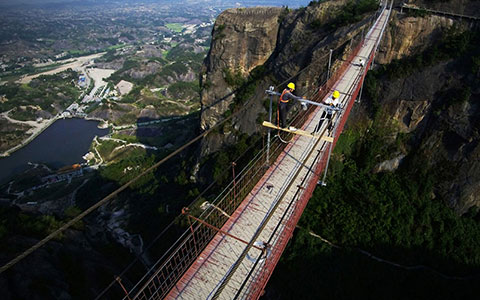Rise of the robots
Updated: 2015-09-14 07:58
By Cheng Yingqi and Shan Juan(China Daily)
|
||||||||
|
Visitors examine a robot designed to serve the elderly at an expo in Anhui province, on Aug 14. Guo Chen / Xinhua |
Job makers or breakers?
The fact that robots - which don't require air-conditioned offices, paid vacations or frequent salary raises - appear to be ideal employees and few humans can hope to compete with them, naturally raises another question: What if robots perform so well that humans become redundant and unemployment rises?
Industry experts said that such a scenario is improbable. "It's unlikely that there will be a conflict between the installation of robots and employment levels in China in the next five years," Qu Daokui, president of Siasun Robot & Automation Co, said.
Qu said the application of industry robots is limited to only a few fields such as welding, hauling and stacking - repetitive, strenuous manual labor that few people wish to do - so using robots to replace the humans currently engaged in these tasks is unlikely to affect the employment rate.
Statistics released by the International Federation of Robotics shows that the major applications for industrial robots include handling, welding, assembly, dispensing, processing and "clean room" work in dust-free environments.
Although most of the robots are used on automobile production lines (38 percent) and the manufacturing of electronic products (27.6 percent), they are also gradually being adopted by traditionally labor-intensive industries, such as foodstuffs and plastic wares, sectors that have suffered most from the labor shortage in recent years.
"From Germany to South Korea to China, a direct factor in employment has been the economic cycle of a country, not the rising number of robots being installed," Qu said.
Wang Yuechao, director of the Bureau of Major R&D Programs at the Chinese Academy of Sciences, said that based on current technology, robots are unable to perform complex tasks that are currently undertaken by senior skilled workers.
"A six-joint robot is already the most sophisticated thing that engineers can build using the current available technology, but its flexibility doesn't compare with our hands at all," Wang said. "So the range of jobs in which robots will replace humans is too narrow to threaten overall employment levels."
Moreover, a report by the International Federation of Robotics said a prosperous robotics industry could created 1 million to 2 million jobs between 2017 and 2020.
"Our study proves that robots create jobs," said Gudrun Litzenberger, general secretary of the federation, in a written statement.
Take Germany, for example, where the number of robots per 10,000 workers rose from 146 in 2000 to 261 in 2011, accelerating manufacturing volume and lowering the unemployment rate from 6.9 percent to 6 percent.
"It's a fact that productivity and competitiveness are indispensable for a manufacturing enterprise to be successful in the global market. Robotics and automation are the solution," Litzenberger said.
 Djokovic beats Federer to win second US Open title
Djokovic beats Federer to win second US Open title
 The world in photos: Sept 7-13
The world in photos: Sept 7-13
 Hanging in the air: Workers risk life on a suspension bridge
Hanging in the air: Workers risk life on a suspension bridge
 Top 5 best-selling wearable devices brands
Top 5 best-selling wearable devices brands
 Photographer captures China's love affair with cellphones
Photographer captures China's love affair with cellphones
 Americans mark the 14th anniversary of 9/11 attacks
Americans mark the 14th anniversary of 9/11 attacks
 7 ways Chinese travelers benefit from the US visa extension
7 ways Chinese travelers benefit from the US visa extension
 In pictures: School life from the lens of sports teacher
In pictures: School life from the lens of sports teacher
Most Viewed
Editor's Picks

|

|

|

|

|

|
Today's Top News
Kissinger anticipates promising China-US ties
Germany re-imposes border controls to slow migrant arrivals
Thousands flee California wildfire as homes go up in flames
Museum crowds wait six hours to see ancient scroll
Slow growth may spur more support
Over 14,500 Chinese pilgrims in Mecca
Xi's trip to US to 'chart course' for ties
US to accept 10,000 Syrian refugees, says White House
US Weekly

|

|









